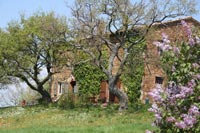Villa Vistarenni is located between the towns of Radda and Gaiole in Chianti, two key production centres in the history of the Chianti Classico in Tuscany.
Vistarenni derives from Fisterinne, Etruscan name that means good view, was a small, fortified settlement that still existed in the year 1000 on the same place, where the villa stands nowadays.
A former property of the Florentine Strozzi family, and later of the Sonnino family, which gave birth to some senior officers of state in early Italian governments, now belongs to the Tognana family. Vistarenni or "Fisterinne" is known to have been one of the rural settlements that in Roman-Etruscan times studded the territory around the Etruscan centre of Cetamura. From its very beginnings it was a small village, recorded in early Middle-Age documents: the oldest of these, in the register of the monastery of San Lorenzo in Coltibuono, is a sales contract where the borders with S.Donato in Perano were the established.
In 1400 the Florentine land register mentions the built-up area of Vistarenni, which at that time comprised 6 or 7 houses and belonged to a large landowner of the area Giovanni di Cecchino da Panzano.
In 1621 Vistarenni became the property of the Florentine Giannozzo da Cepparello and in 1714 passed to certain exponents of the Chianti family Pianigiani. That was the end of the old village Vistarenni and on the same area arose the large building of the villa-farm with courtyard, kitchen garden and "olive mill"; a building which still perpetuated in some ways the Renaissance architectural tradition with its regular plano-volumetric structure and lines of windows in the white walls.
The cellars were enlarged, excavating into rock, and covered by cross vaults in terra cotta interspersed with depressed arches. The estate at that time covered 78 hectares.
In 1852 the whole Pianigiani property was sold to the Prince Ferdinando Strozzi and was managed for about 40 years by this aristocratic Florentine family whose coat-of-arms can still be seen in some parts of the manor house of Vistarenni. Prince Strozzi was a member of the Tuscan Assembly in 1859 and was named Senator of the Kingdom of Italy in 1860. The estate consisted in 26 holdings located in the Communes of Radda and Gaiole, all with farmhouse, yard or threshing floor and shed, and was managed according to the traditional system of agricultural agreements and subsequent share-cropping.
At the end of the nineteenth century and more precisely in 1892, Baron Giorgio Sonnino, brother of Sidney, who was Prime Minister in 1906 and 1909, took over from the Strozzi family.
A science graduate from the university of Pisa, Baron Sonnino lived in San Miniato di Firenze and was elected Senator of the Kingdom in 1868.
The books and documents in the villa's library are evidence of his vast ranging interests: from agriculture to public finance, from merchant shipping to African affairs and especially the colony of Eritrea. The Estate was enlarged from that moment on until it covered an overall area of 650 hectares.
The average annual production of Chianti wine was at that time over 2300 hectolitres; a wine that was particularly esteemed for its qualities of " robustness, fineness and preservability".
Sonnino had the façade of the villa embellished and between 1914 and 1919 the four pilaster strips of the central body, the lintels ( arched and flat ) over the windows of the piano nobile and the large staircase with two flights were added to design by the Florentine architect Ludovico Fortini.
A chapel also remains: a small sixteenth-century construction in Neo Renaissance style, which bears the date 1584 on the lintel. It was used as Sonnino family vault and was dedicated to the Florentine saint Maria Magdalena de'Pazzi ( 1566-1607), one of the most important and worshipped ecstatic saints of the Catholic faith.
In the parc there is a small chapel, dedicated to Santa Maddalena de'Pazzi.
|











